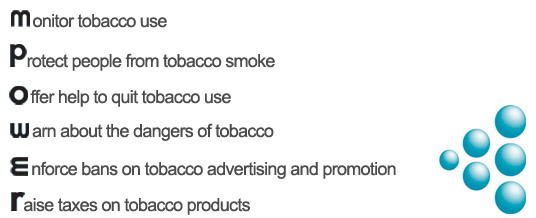
Tobacco use represents a serious challenge to ongoing efforts to prevent noncommunicable diseases (NCDs) in many countries in the Region. The main NCDs, namely cardiovascular diseases, cancers, chronic respiratory diseases and diabetes are the leading cause of premature death in countries of the Eastern Mediterranean Region, responsible for more than 2.8 million deaths every year. Other NCDs include: hypertension, Alzheimer's and osteoporosis.
Collectively, the main NCDs are responsible for 66% of all deaths in the Region. Over half of NCD deaths are premature, occurring before the age of 70. These premature deaths are linked to unhealthy behaviours, or risk factors, including tobacco use.
The tobacco epidemic is one of the biggest public health threats the world has ever faced, killing more than 8 million people a year globally. Approximately one person dies every 4 seconds due to tobacco, and up to half of current users will eventually die of a tobacco-related disease. Tobacco can also be deadly for non-smokers. Second-hand smoke exposure has also been implicated in adverse health outcomes, causing 1.2 million deaths annually worldwide.
Nearly half of all children breathe air polluted by tobacco smoke and 65 000 children die each year due to illnesses related to second-hand smoke. An estimated 1.3 billion people worldwide use tobacco products, 80% of whom are in low- and middle-income countries. Tobacco use contributes to poverty by diverting household spending from basic needs, such as food and shelter, to tobacco. This spending behaviour is difficult to curb because tobacco is so addictive. It also causes premature death and disability of productive age adults in households thus leading to reduced household income and increased healthcare costs.
Quitting tobacco
Quitting tobacco can be challenging, especially with the added social and economic stress that have come as a result of the pandemic but the benefits of quitting tobacco are almost immediate.
Within 20 minutes, your heart rate and blood pressure drop.
12 hours, the carbon monoxide level in your blood drops to normal.
2–12 weeks, your circulation improves and your lung function increases.
1–9 months, coughing and shortness of breath decrease.
1 year, your risk of coronary heart disease is about half that of a smoker's.
5 years, your stroke risk is reduced to that of a nonsmoker 5–15 years after quitting.
10 years, your risk of lung cancer falls to about half that of a smoker and your risk of cancer of the mouth, throat, esophagus, bladder, cervix and pancreas decreases.
15 years, the risk of coronary heart disease is that of a nonsmoker.
Tobacco control efforts
WHO Framework Convention on Tobacco Control
To control tobacco, WHO Member States negotiated the WHO Framework Convention on Tobacco Control (WHO FCTC). The WHO FCTC is the first international treaty negotiated under the auspices of WHO. It was adopted by the World Health Assembly on 21 May 2003 and entered into force on 27 February 2005. It has since become one of the most rapidly and widely embraced treaties in United Nations history.
The WHO FCTC was developed in response to the globalization of the tobacco epidemic and is an evidence-based treaty that reaffirms the right of all people to the highest standard of health. The Convention represents a milestone for the promotion of public health and provides new legal dimensions for international health cooperation.
Tobacco control is going through a transitional period in many countries. Following the successful phase of ratification of the WHO FCTC, various sociopolitical factors are adversely affecting tobacco control efforts. Other social and economic priorities are now being given precedence over tobacco control, which directly threatens the gains made in this area and endangers the improvements in tobacco control at the legislative, health and economic fronts. The implications go beyond tobacco, posing a serious threat to ongoing efforts to prevent NCDs in many countries.
Implementing the evidence-based, legally binding provisions of
WHO'S FCTC to their fullest extent represents the world's best chance of reducing tobacco
MPOWER measures to reduce the demand for tobacco
There is also the MPOWER package that WHO released in 2008 to support the implementation of the WHO FCTC, which has proven very successful in controlling tobacco. MPOWER is an acronym for 6 key tobacco control measures, each corresponding to at least one provision of the treaty:



